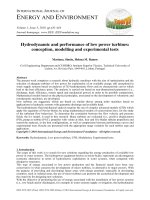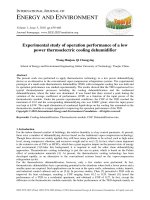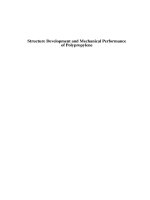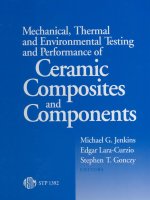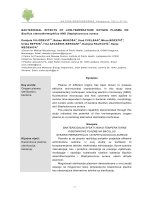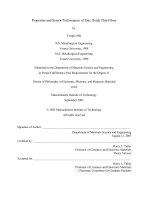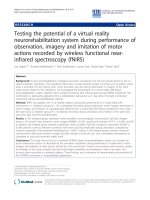- Trang chủ >>
- Khoa Học Tự Nhiên >>
- Vật lý
Hydrodynamic and performance of low power turbines: conception, modelling and experimental tests
Bạn đang xem bản rút gọn của tài liệu. Xem và tải ngay bản đầy đủ của tài liệu tại đây (2.06 MB, 14 trang )
INTERNATIONAL JOURNAL OF
ENERGY AND ENVIRONMENT
Volume 1, Issue 3, 2010 pp.431-444
Journal homepage: www.IJEE. IEEFoundation.org
Hydrodynamic and performance of low power turbines:
conception, modelling and experimental tests
Mariana. Simão, Helena M. Ramos
Civil Engineering Department and CEHIDRO, Instituto Superior Técnico, Technical University of
Lisbon, Av. Rovisco Pais, 1049-001, Lisbon, Portugal.
Abstract
The present work comprises a research about hydraulic machines with the aim of optimization and the
selection of adequate turbines of low power for exploitation of an available energy still unexplored in
water supply systems based on analyses of 3D hydrodynamic flows and on characteristic curves which
lead to the best efficiency point. The analysis is carried out based on non-dimensional parameters (i.e.,
discharge, head, efficiency, runner speed and mechanical power) in order to be possible comparisons.
Mathematical models based on the physical principles, associated to the development of volumetric and
rotordynamic machines, are developed.
New turbines are suggested, which are based on similar theory among turbo machines based on
applications in hydraulic systems with guarantee discharge and available head.
The hydrodynamic fluid mechanical analysis requires the use of complex advanced models (CFD) which
apply the equations of Navier-Stokes by using mathematical models of conservation laws, for the study
of the turbulent flow behaviour. To determine the correlation between the flow velocity and pressure
fields, the k-ε model, is used in this research. Many turbines are evaluated (i.e., positive displacement
(PD), pump as turbine (PAT), propeller with volute at inlet, four and five blades tubular propellers) and
sensitivity analyses, to the best configurations, as well as comparisons between performance curves and
experimental tests. Results are presented with the appropriate range variation for each turbine type and
application.
Copyright © 2010 International Energy and Environment Foundation - All rights reserved.
Keywords: Hydrodynamic, Low power turbines, CFD, Modulation, Experimental tests.
1. Introduction
The scope of this work is to search for new solutions regarding the energy production of available low
power in water systems. The hydropower equipment known as micro-hydro, represents an advantageous
economic alternative in terms of hydroelectric exploitation in water systems, when compared with
dissipative structures.
This type of energy associated to low power production and the financial search have been very
conservative in what concerns the development of micro turbines, in alternative to major powers. With
the purpose of providing and developing future areas with energy potential, especially in developing
countries, rural or isolated areas, the use of micro-turbines can promote the economical development and
the creativity for designing new solutions.
With the objective of promoting the use of energy associated with the installation of low power systems
(i.e., low heads and/or discharges), for example in water systems supply or irrigation, the hydrodynamic
ISSN 2076-2895 (Print), ISSN 2076-2909 (Online) ©2010 International Energy & Environment Foundation. All rights reserved.
432
International Journal of Energy and Environment (IJEE), Volume 1, Issue 3, 2010, pp.431-444
flow through the selected turbines to these conditions and the estimation of the best efficiency point, with
the aim of finding new possible applications in systems already existent, are developed.
2. State-of-the-art
2.1 Hydraulic machines
The hydraulic machines make possible changes between mechanical and hydraulic energy through two
processes of transformation, depending on the transmission direction, namely in pumps or turbines.
These machines have complex characteristics, which allow their differentiation and classification [1].
From the mechanical point of view, the hydraulic engines can be classified as hydraulic turbo and
volumetric engines.
2.2 Turbo machines
In turbomachines the flow movement is done by forces developed by the liquid, in the impeller blades,
caused by the rotation of the runner. These equipments can be classified in motor engines (turbines) and
in receptor engines (pumps) [2]. Despite the place where they work, the motor engines divide themselves
in two different groups: action and reaction turbines. When the impeller is driven by the water at the
atmospheric pressure, the turbines are of action type (e.g., Pelton), when the propeller is crossed by the
flow under pressure, the turbines are of reaction type (e.g., Francis and Kaplan) (Figure 1). Another type
of impulse turbine, similar to Pelton turbine, is the Turgo turbine, which is less efficient but can deal with
higher discharge variations and create the same power as the Pelton runner, which has the twice
diameter.
(a)
(b)
(c)
(d)
(e)
(f)
Figure 1. Turbine impellers: action: (a) Pelton; (b) turgo; (c) cross-flow; reaction: (d) radial Francis; (e)
mixed Francis; (f) Kaplan
The cross-flow hydraulic turbine can be classified as an impulse turbomachine with partial admission.
Nevertheless the efficiencies of this type of turbine show a great dispersion and variation between 51 and
82%, below the ones of the hydraulic most conventional turbines have. The pumps are receptor hydraulic
machines which transfer energy to the fluid with the purpose to carry it. They can be classified in two
great groups: turbo pumps and volumetric engines. The pumps distinguish themselves by the form and
the type of impeller, which can be classified as: radial or centrifugal pump, mixed and axial pumps
(Figure 2).
(a)
(b)
(c)
Figure 2. Pump impellers: (a) radial; (b) mixed; (c) axial impellers
2.3 Volumetric machines
In volumetric machines or positive displacement machines, the transference of energy is made by volume
variations which occur when the fluid is confined in a chamber or in the passage [1]. In volumetric
pumps or positive displacement pumps, the movement of the fluid is caused mainly by the action of the
pump impulsion, which forces the fluid to make the same movement over and over again (such as piston,
gears, lobes, vanes) in alternating movements. This pump is named volumetric, because the fluid
occupies and evacuates in a successive way the interior of the pump with known volumes. These pumps
ISSN 2076-2895 (Print), ISSN 2076-2909 (Online) ©2010 International Energy & Environment Foundation. All rights reserved.
International Journal of Energy and Environment (IJEE), Volume 1, Issue 3, 2010, pp.431-444
433
can also be sub-classified as rotating pumps (gears, lobes, vanes, helicoidal, bobbins, screws, peristaltic)
and as pistons or alternative pumps (pistons, diaphragm, membrane).
2.4 Pumps as turbines
When a pump induces a certain power to the flow, it is necessary that a quantity promotes the fluid
pumping which in many cases cannot happen and can lead to an inverted rotation of the impeller, and
consequently the change of the fluid direction, from downstream to upstream, to the suction line [3]. The
most appropriate energy converters in water pipe systems can be of two types: turbines and pumps as
turbines (PAT - Figure 3) [4-8].
Figure 3. PAT performance curves (adapted from [6, 7])
2.5 Comparing hydraulic machines
The transference of mechanical energy to the impeller can be made from (i) volumetric alternative
machines or rotary ones, like the ones of positive displacement type, or from (ii) rotary dynamic
machines. Comparing the analysis between centrifugal pumps and rotary pumps, some conclusions can
be drawn (Figure 4): (i) the rotary are more appropriate to viscous fluids and to discharges until 200 l/s,
while the centrifugal pumps can pump till 7600l/s, (ii) the efficiency and the energy costs are in general
better in rotary pumps, (iii) the rotary pumps have a higher control of flow, (iv) both machines have a
similar life time [9].
efficiency
Q (l/s)
8
1
7
0,9
0,8
6
0,7
5
0,6
4
0,5
3
2
0,4
centrifugal (H-Q)
PD (H-Q)
0,3
centrifugal (H-eff iciency)
0,2
PD (H-efficiency)
1
0,1
0
0
15
20
H (m)
25
30
Figure 4. Centrifugal pumps and positive displacement (PD): discharge, efficiency versus pressure [10]
ISSN 2076-2895 (Print), ISSN 2076-2909 (Online) ©2010 International Energy & Environment Foundation. All rights reserved.
434
International Journal of Energy and Environment (IJEE), Volume 1, Issue 3, 2010, pp.431-444
Generally speaking, the PD pumps can produced more pressure than the centrifugal ones and they are
also more used to fluids of higher viscosity [11]. The PD pumps can be also used when the installation
condition demands a variable pressure. Another important factor is the rotation speed, which a PD pump
can attain, lower values and with a constant discharge [10].
2.6 Similarity in turbo machines
The behaviour of these models is based on the theory of the hydraulic similarity, which consists in three
essential laws: geometric similarity, kinematic similarity and dynamic similarity. For the geometric
similarity, the dimension of the turbine cannot be reduced to a smaller scale which can induce scale
effects in the prototype. In kinematic similarity, the triangle of speeds is equivalent in the inlet and outlet,
and in the dynamic similarity the polygon of forces must be similar both in the prototype as in the model
[12, 13]. The validation of these conditions gives a scientific approach to select the turbine that best
adjusts to the project conditions.
(1)
If both machines have the same diameter and operates in similar conditions, then can verify the
equivalence of equation (1).
In mathematics analyses, it is possible to describe the neuron by writing the following par of equations:
3. Hydraulic machines conception
3.1 Piston pumps
In piston pumps, there is a piston that moves alternatively as the result of forces which act over it. This
alternative movement, rectilinear, is transmitted to the rod/handle and there it is transformed in a
continuous circle movement. The transformation of an alternative linear movement of a piston
throughout the rotation of the shaft of a generator can be made by a known mechanism as handle and
rod, presented in (Figure 5).
Figure 5. Relations about linear movement of the piston (adapted from [10])
When the friction and the inertia of the moving parts are neglected, the binary power generated in the
handle by the axial force FP given to the piston and directed in the positive direction x is:
(2)
Comparing this equation to the one of the piston speed results in M/FP = v/ω. The validation of this
relation is clear, because the power given by the fluid to the piston must be equal to the power
transmitted by the handle to the shaft (P = M ω).
The elimination of null binary points, which is seen in simple pistons, can only be achieved through two
double-effect displaced by 90º or three single-effect cylinders displaced by 120º (Figure 6). The degree
of flow and binary capacity depends on the size of the rod when compared to the size of the handle.
There is an advantage in using the largest possible rod and in reducing the length of the handle [10].
Other aspects to take into account are the size, turbulence and vibration degree of these engines.
However, for large elevations and small flows, these engines may be the best solution, if pressure is
ISSN 2076-2895 (Print), ISSN 2076-2909 (Online) ©2010 International Energy & Environment Foundation. All rights reserved.
International Journal of Energy and Environment (IJEE), Volume 1, Issue 3, 2010, pp.431-444
435
higher than 20 or 30 atm. Up that limit multiple stage centrifugal pumps can be used. Nevertheless, this
might not be an economically viable solution.
Figure 6. Variation of discharge and binary with two and three pistons of double or single effect out of
phase of 90º and 120º
3.2 Positive displacement pumps
This engine consists mainly of a chamber whose internal shape is an epicycloid where inside there is an
impeller with an almost triangular structure, which with its circle sides runs eccentrically to the principal
axis. Throughout the movement of the triangle sides, these normally seal the cycle and the space between
the impeller and the chamber increases and decreases, so making possible the suction process in the
entrance of the fluid [14]. Hence the flux is made through entrances, neglecting the use of valves and
consequently its command mechanisms. Being this machine adapted to conditions, where the fluids are
incompressible, the cycle of four stroke engine sets with only four isolated phases, as identified in
(Figure 7).
Figure 7. General positions of sealing the impeller for the positive displacement engine
However this engine has some disadvantages as a non flexible power curve to the variations and the
problems in maintaining an ideal seal between the impeller and the chamber, due to the thermal
dilatation, causing some difficulties in the specification definition and minimal accepted errors in the
production [10].
3.3 Volumetric machines selection
The purpose of this study allow us to conclude that alternative volumetric machines or positive
displacement engines, seem to be the most adequate regarding the energy conversion. The idea of
creating energy from a turbine inspired in the Wankel motor, becomes an interesting solution with less
variation of discharge, when installed in water supply systems, as the liquid is an almost incompressible
fluid with steady flow conditions most of the times (with a constant discharge) [19].
3.4 Propeller turbines
The study in micro turbines is not highly developed, which allows studying its efficiency and versatility,
searching and developing experimental components as computational models. So this study presents
analyses of new or adapted hydraulic energy converters more appropriate to micro-hydro (i.e., low
power) which can be easily installed in rural areas or isolated zones or even in urban areas such as in
water supply systems with available energy which must be dissipated due to feasibility and security
factors [15].
ISSN 2076-2895 (Print), ISSN 2076-2909 (Online) ©2010 International Energy & Environment Foundation. All rights reserved.
436
International Journal of Energy and Environment (IJEE), Volume 1, Issue 3, 2010, pp.431-444
4. Mathematic modelling
4.1 Navier-Stokes equations
Since the fluid is considered a continuous mean, it is assumed that it is possible to define physical
variables such as pressure, velocity and density for a specific point of a fluid. Thus, constitutive
equations of the flow are equations for the mass and momentum conservation, which can be derived from
Reynolds transport theorem [16]. The differential form of the mass conservation equation, usually
denominated as continuity equation, can be obtained by applying Gauss’s theorem,
⎛ ∂ρ ∂(ρ u i ) ⎞
(3)
∫∀ ⎜ ∂t + ∂x ⎟ d∀ = 0
⎜
⎟
⎝
i ⎠
To obtain the linear momentum balance equation, the second Newton law is applied to a fluid particle,
∫
∀
∂ (ρ u i )
d∀ +
∂t
∫
A
r r
ρ u i (v • n )dA =
∫
∀
ρ g i d∀ +
∫
A
σ i dA
(4)
Equations valid for isotropic fluids, incompressible and of constant viscosity, together with the continuity
equation, can determine pressure and velocity flow (with three components) in all points,
ρ
∂u j
∂t
+ ρu i
∂u j
∂x i
= ρgj −
∂p
∂
+
∂x j ∂x j
⎛ ∂u i
⎜λ
⎜ ∂x
i
⎝
⎞
∂ ⎛ ⎛ ∂u i ∂u j ⎞ ⎞
⎜ ⎜
⎟⎟
⎟+
⎟ ∂x ⎜ µ⎜ ∂x + ∂x ⎟ ⎟
i ⎝ ⎝
j
i ⎠⎠
⎠
(5)
In the so-called Newtonian fluids, it is assumed that the tensor of tensions varies linearly with the
velocity tensor which the deformation is processed, therefore obtaining the Navier-Stokes equations valid
for the three axis.
4.2 Turbulence model k-ε
Associated with turbulent flow, rotational zones and intermittent diffusion effects, very uncoordinated
and dissipative can be identified. The zones which present the highest vortex-movement by interacting
with the flow take part of its kinetic energy. The rate of the energy dissipation, which is transformed in
turbulent movement is the only energy available to develop small rotation movements and is the only
energy to be dissipated. Hence, the rate of energy dissipation used in a large scale movement is achieved
through the viscosity action, which takes place in small scale movements. The higher the number of
Reynolds (smaller viscosity effects), lesser dissipative effects from rotation will be obtained, relatively to
the scale of the flow. According with the simplifications of fluid transportation equations, it is possible to
establish a parallelism between these equations and the equations used in the turbulence model, kepsilon. The model k-ε is a semi-empiric model based on the equations for turbulence (k) kinetic energy
transportation and its dissipation rate (ε). When deriving the k-ε model, it is assumed that the fluid is
totally turbulent and that the molecular viscosity effects are insignificant.
5. Computational Fluid Dynamic (CFD)
5.1 Fundamentals
Within computational fluid dynamic, the CFD models (Computational Fluid Dynamics) are important
tools for the analysis of different scenarios and boundary conditions which are difficult to model
experimentally. These codes allow a better understanding of different hydraulic turbines and flow
conditions [10]. In fact, these computational fluid mechanical models are largely used [17]. for
compressible and incompressible flows, leading to high precision optimal solutions for a large range of
flow velocities. FLUENT is a hydrodynamic model which applies a finite volume technique in order to
solve equations for describing the flow behaviour, through the resolution of the continuity equation and
the Euler or Navier-Stokes equations (also known as Reynolds equations).
5.2 Definition of the mesh
The success of the computational calculation of turbulent flows demands a special attention during the
generation of the grid. As long as turbulence (from the effective variable viscosity in space) plays a
dominant role in dynamic transportation, as well as other parameters, it should be verified that turbulence
quantities in complex turbulent flows are duly solved with high precision. Due to the strong interaction
ISSN 2076-2895 (Print), ISSN 2076-2909 (Online) ©2010 International Energy & Environment Foundation. All rights reserved.
International Journal of Energy and Environment (IJEE), Volume 1, Issue 3, 2010, pp.431-444
437
between the flow and the turbulence, numerical results for the turbulent flow tend to be more sensitive to
the dependence of the grid than to the laminar flow. Therefore, it should be solved with a sufficiently
thin mesh, in regions where there are rapid flow changes and a large tangential tension concentrated [17].
5.3 Simulation results (CFD)
This study is about five innovative solutions for energy exploitation in water supply systems. These
solutions may result in a good relation between cost and efficiency, as an alternative to conventional
turbines, especially for micro-hydro turbines, due to the simplicity of their project. Therefore, a positive
displacement turbine (PD), a pump as turbine (PAT), a propeller-type turbine with an upstream volute
and tubular propellers, are engines which can operate as new turbines using volumetric flow or mutation,
which cause the rotation of a rotor or a runner. Numeric simulations help to investigate different types of
configurations and parameters which can be of difficult experimental implementation [18]. Thus, it is
important that the mesh is duly conceived and refined in areas of difficult modelling, such as the blade
thickness (Figure 8).
(a)
(b)
(c)
(d)
(e)
Figure 8. Computational mesh: (a) positive displacement (PD); (b) tubular propeller with 5 blades; (c)
tubular propeller with 4 blades; (d) propeller with volute; (e) PAT
The flow inside each engine is described in Figure 9. For the positive displacement rotational turbine
(PD), flow passes around the rotor and comes out in a similar way through two entrances and two exists
(Figure 9 - left).
(a)
(b)
(c)
(d)
(e)
Figure 9. Pathlines variation (m/s): (a) positive displacement (PD); (b) tubular propeller with 5 blades;
(c) tubular propeller with 4 blades; (d) propeller with volute; (e) PAT
For the PAT and remaining propellers, flow enters without large constraints, from the surrounding,
passing rapidly through the runner, since it is influenced by the rotation of the rotor, coming out, through
the draft tube, with some rotation (Figure 9).
(a)
(b)
(c)
(d)
(e)
Figure 10. Total pressure variation: (a) positive displacement (PD); (b) tubular propeller with 5 blades;
(c) tubular propeller with 4 blades; (d) propeller with volute; (e) PAT
ISSN 2076-2895 (Print), ISSN 2076-2909 (Online) ©2010 International Energy & Environment Foundation. All rights reserved.
438
International Journal of Energy and Environment (IJEE), Volume 1, Issue 3, 2010, pp.431-444
Quantitative results, obtained from the CFD model in terms of total pressure, intensity and tangential
strength along the turbine walls, are explained in Figures 10, 11 and 12, respectively.
(a)
(b)
(c)
(d)
(e)
Figure 11. Turbulence intensity variation (%): (a) positive displacement (PD); (b) tubular propeller with
5 blades; (c) tubular propeller with 4 blades; (d) propeller with volute; (e) PAT
These simulations allow us to identify critical zones which affect the efficiency of the turbine and
consequently the power transmitted to the generator.
(a)
(b)
(c)
(d)
(e)
Figure 12. Wall shear stress variation: (a) positive displacement (PD); (b) tubular propeller with 5 blades;
(c) tubular propeller with 4 blades; (d) propeller with volute; (e) PAT
The results obtained from the mathematical model are the consequence of an exhaustive sensitivity
analysis in the search for the point of best efficiency for each engine. A sequence of graphics can be
observed, depending on head and discharge coefficients, in order to cover a large range of applications
(Graphics 1 and 2).
Graphic 1. Variation of the discharge and head number and efficiency for different speed runner: in
positive displacement turbine; propeller with 5 blades; propeller with 4 blades
In order to analyse the variability of flow velocity along the surrounding turbine, several plans by
sectioning the entrances and exists of the flow, the upstream and downstream runner and other plans
where it was difficult to understand the behaviour of the fluid inside the engine are created (Figure 13).
For the PD turbine, the first graph represents the flow velocity at the entrance and exit the turbine, where
lower values correspond to exits and higher values to entrances, The volume flow entering and exiting
the turbine is practically the same, having as a consequence a almost constant discharge during the
turbine operation.
ISSN 2076-2895 (Print), ISSN 2076-2909 (Online) ©2010 International Energy & Environment Foundation. All rights reserved.
International Journal of Energy and Environment (IJEE), Volume 1, Issue 3, 2010, pp.431-444
439
Graphic 2. Variation of the discharge and head number and efficiency for different speeds runner: in
propeller with upstream volute and in a pump as turbine
Figure 13. Plans defined in the turbines
For these plans, velocity graphics are analysed for each turbine, as indicated in Figure 14.
Figure 14. Velocity variation in entrance and exit plans
(a)
(b)
(c)
(d)
(e)
Figure 15. Flow velocity variation along the depth for the tubular propeller with 5 blades
In Figure 15, the flow enters at an average velocity of 1.1 m/s, reducing this value as it approaches the
walls. As it approaches the curve, an anisotropy in the distribution of the flow velocity is observed,
caused by the influence of the axis (Figure 15 (b)).
Relating Figure 15 (b) with (c), a certain similarity in the distribution of the flow velocity is observed,
despite some differences caused by the proximity of the flow to the runner. According with Figure 15 (d)
and (e), as flow is drawn from the propeller, it is influenced by the low pressure effect at downstream the
propeller runner shaft (separation zone), causing a decrease in the level of pressure and flow velocity in
this section.
ISSN 2076-2895 (Print), ISSN 2076-2909 (Online) ©2010 International Energy & Environment Foundation. All rights reserved.
440
International Journal of Energy and Environment (IJEE), Volume 1, Issue 3, 2010, pp.431-444
(a)
(b)
(c)
(d)
(e)
(f)
Figure 16. Flow velocity variation along the depth for the tubular propeller with 4 blades
In the four-blades tubular propeller, Figure 16 (a), the distribution of flow velocity presents higher values
at tubular middle, because the friction of the solid walls causes flow velocity tends to zero in those zones.
Taking into consideration Figure 16 (c), once again is verified the effect of the runner rotation axis in the
analysis of the flow in the curve. Comparing it with (d), the flow assumes an identical behaviour, despite
the higher discrepancy along the axis symmetry, as well as in the average value reached by the flow
velocity, which is slightly higher. Figure 16 (e) also shows some rotational effect of the propeller, which
disperses the flow velocity in the section at downstream of the turbine region.
(a)
(b)
(c)
(d)
(e)
(f)
Figure 17. Flow velocity variation along the depth for the propeller with volute upstream
In Figure 17 (a), the flow velocity increases as it approaches the area of passage through the runner, not
only due to the variation of the section, but also due to the effect associated with the rotation of the
propeller. In Figure 17 (b), the flow enters the volute with a more uniform value, increasing with the
rotational movement introduced by the turbine. In Figure 17 (c), the effect that the configuration of the
volute transmits to the flow is visible, which forces it to follow the geometry of the volute, leading to an
increase of the velocity once it comes into contact with the casing where the propeller is installed. When
the flow hits the blades, it increases its velocities as it is drawn further away from the shaft, due not only
to the tangential rotational strength, as well as to the effect of the centrifugal force, which projects the
flow against the wall of the draft tube (Figure 17 (e)). In jit plan, shown in Figure 15 (f), the effect of the
runner is noticed with a tendency to stabilize to the axial movement at tailrace.
(a)
(b)
(c)
(d)
(e)
Figure 18. Flow velocity variation along the depth for a pump as turbine (PAT)
Concerning Figure 18 (b), the dispersion of the velocity values is due to the rotation of the runner leading
to lower average speed values caused by the associated turbulence increasing. In Figure 18 (c) and (d) it
is possible to observe the behaviour of the fluid due to the rotational movement of the runner adjacent
zone. In Figure 18 (e) (vertical plan), the effect caused by the rotation of the runner and in the lower flow
velocity values, which correspond to the draft tube, a vortex formation is visible.
ISSN 2076-2895 (Print), ISSN 2076-2909 (Online) ©2010 International Energy & Environment Foundation. All rights reserved.
International Journal of Energy and Environment (IJEE), Volume 1, Issue 3, 2010, pp.431-444
441
6. Comparison between simulation and tests
In some turbines, velocity profiles can be compared with real values, in lab tests. With the help of a
Doppler (3000 series), the phenomenon induced by the runner rotation of the propeller is detected
(Graphic 3).
(a)
(b)
(c)
(d)
(e)
Graphic 3. Flow velocity profiles: (a) at the upstream curve; (b) in the curve; (c) upstream the turbine; (d)
downstream the turbine; (e) downstream of the turbine zone
This study includes the analysis of the flow velocity profile obtained experimentally and through the
computational simulation. There is a match between results from rotation effects, friction and turbulence
which lead to an anisotropy behaviour upstream and downstream the turbine (Figure 16 (a), (d) and (e)
with Graphic 3 (a), (c) and (d)).
The numerical simulation was confined to hydrodynamic studies and, therefore, some of the real effects
could not be modelled, such as friction and leaks which can occur in sealing areas, which are not
accounted for in the CFD simulations. Thus, in order to promote a reliable evaluation of the CFD results,
lab physical models are developed for a few turbines and compared with the theoretical results. These
analyses show a few leaks and scale effects which the CFD cannot reproduce correctly. The
dimensionless characteristic parameters are selected and compared between CFD simulations and lab
tests.
The comparison between CFD simulations for different turbines under analysis and, simultaneously, with
some of lab tests show the characteristic curves typical for each engine (Graphics 4 and 5).
These trend curves are drawn based on the optimal best efficiency point estimated by the CFD model and
the experimental results.
Graphic 4. Comparisons between experimental test and simulation: PD turbine; tubular propeller with 5
blades; and with 4 blades
Graphic 5. Comparisons between experimental test and simulation: propeller with volute at upstream;
and a PAT
ISSN 2076-2895 (Print), ISSN 2076-2909 (Online) ©2010 International Energy & Environment Foundation. All rights reserved.
442
International Journal of Energy and Environment (IJEE), Volume 1, Issue 3, 2010, pp.431-444
From the analysis of these graphics, the simulation results are located above the lab results, due to losses
and leaks which are not considered in the mathematical model. The choice for dimensionless parameters
facilitates the comparison between turbo-machines similarity, allowing the creation a summary table for
the conditions of each selected turbine [19].
Table 1. Results obtained for the new selected energy converters [19]
Figure 19. Geometry for different turbines (Unit: 10 mm)
On Table 1 and Figure 19, a summary of all energy converters is presented with the main purpose of
covering for the scarcity of energy engines with low power which can be applied in most of the water
supply, irrigation or drainage systems.
It is possible to identify a wide range of application which conventional turbines cannot adequately and
or economically cover. Furthermore, these turbines have not only an interesting economical advantage,
but also in what concerns its easy conception or manufacture. These engines are, in general, composed
only by a (very simple) rotor and, consequently, are able to operate in almost constant flow conditions,
like it happens in trunk main water supply systems, or in systems equipped with flow control valves.
7. Conclusions and recommendations
The computational analysis together with theoretical mathematical and physical methods help to
understand the hydrodynamic phenomenon in each turbine, leading towards a higher perception of the
interaction between the geometric and hydrodynamic characteristics, in what concerns flow entrance and
exit in the different turbines and when passing around/through the rotor. In the case of propeller turbines,
this interaction allows an analysis of the best solution, in terms of project of the blades to adopt and,
therefore, from a good calculation base, this difficulty has become a very interesting and positive
investigation issue.
ISSN 2076-2895 (Print), ISSN 2076-2909 (Online) ©2010 International Energy & Environment Foundation. All rights reserved.
International Journal of Energy and Environment (IJEE), Volume 1, Issue 3, 2010, pp.431-444
443
This research allows to conclude that these new hydraulic energy converters, can be easily manufactured
and installed in regions where the capacity to install is relatively small, with small flows and/or heads,
such as small water courses, water supply and irrigation systems or channels, or in projects in which
conventional turbines are not economically viable. In spite of the fact that this study is still in its initial
stage, it suggests possible new low power turbine configurations, to cover for the scarcity of turbines
with those characteristics in the market. A more detailed analysis to several parameters can be developed
in order to determine the best solution to be adopted in each situation, depending on the location and the
available conditions of the system to be analysed.
The lessons from this work reinforce the need to continue the developments in the energy field, in
systems where it is possible to assure the exploitation of hydro, under specific low power conditions in a
competitive way.
Acknowledgements
To projects HYLOW from 7th Framework Programme (Grant nº 212423) and FCT
(PTDC/ECM/65731/2006) which contributed to the development of this research work, allowing
components of computational dynamic and laboratorial investigation associated to the performance of
turbines of several types to be developed and compared.
References
[1] Macintyre, A.J., Máquinas motrizes hidráulicas, Editora Guanabara Dois S.A. Rio de Janeiro.
1983.
[2] Quintela, A. C., Hidrỏulica, 9ê ediỗóo. Fundaỗóo Calouste Gulbenkian, Lisboa. 2005.
[3] KSB. Pumps and Systems. Techno digest. 2005.
[4] Williams, A., Smith, N.P.A., Bird, C., Howard, M., Pumps as turbines and induction motors as
generators for energy recovery in water supply systems, J. CIWEM, June. 1998.
[5] Joshi, S., Holloway, A.G.L., Chang, L., Selecting a high specific speed pump for low head hydroelectric power generation, IEEE CCECE/CCGEI, Saskatoon, May. 2005.
[6] Singh, P., Optimization of the Internal Hydraulic and of System Design in Pumps as Turbines with
Field Implementation and Evaluation, Ph. D. Dissertation. Germany, University of Karlsruhe.
2005.
[7] Rawal, S., Kshirsagar, J. T., Numerical Simulation on a Pump Operating in a Turbine Mode.
Proceedings of the Twenty-Third International Pump Users Symposium. USA, Texas AM
University. 2007.
[8] Naldi, G., Artina, A., Bragalli, C., Liserra, T., Marchi, A., Experimental investigation of
characteristics curves of centrifugal pumps working as turbines, Integrating water systems, Editors
Boxall & Maksimovic, Taylor and Francis Group (2010) London ISBN 978-0-415-54851-9 UK.
2009.
[9] Jacoby, R., Pump School, Sponsored by Viking Pump, Inc. 2007.
[10] Ramos, H. M., Borga, A., Simão, M., Cost-effective energy production in water pipe systems:
theoretical analysis for new design solutions. 33rd IAHR Congress. Water Engineering for a
Sustainable Environment. Managed by EWRI of ASCE on behalf of IAHR. Vancouver, British
Columbia, Canada, August 9-14. 2009.
[11] Parker, D. B., Positive Displacement Pumps-Performance and application, R&D Testing, Warren
Pumps Incorporated, Proceedings of 11th International Pump Users Symposium. Copyright 1994.
Reprinted with permission of the Turbomachinery Laboratory, Department of Mechanical
Engineering, Texas A&M University, College Station, Texas 77840-3123. 1994
[12] Ramos, H., Simulaỗóo e controlo de transitúrios hidrỏulicos em pequenos aproveitamentos
hidroelộctricos. Modelaỗóo e anỏlise dos efeitos induzidos pela sobrevelocidade. IST. 1995.
[13] Ramos, H., Guidelines for Design of Small Hydropower Plants. ISBN 972-96346-4-5. CEHIDRO,
WREAN and DED, Belfast, North Ireland. 2000.
[14] Hege, J.B., The Wankel Rotary Engine, McFarland & Company, Incorporated Publishers. U.K.,
ISBN-13: 9780786429059. 2006.
[15] Demetriades, G. M., Design of Low-Cost Propeller Turbines for Standalone Micro-hydroelectric
Generation Units, Ph. D. Dissertation. UK, University of Nottingham. 1997.
[16] Barbosa, F., Simulaỗóo numộrica 3D do enchimento de compartimentos de reservatórios utilizando
o método dos elementos finitos. USP - São Paulo. 2007.
ISSN 2076-2895 (Print), ISSN 2076-2909 (Online) ©2010 International Energy & Environment Foundation. All rights reserved.
444
International Journal of Energy and Environment (IJEE), Volume 1, Issue 3, 2010, pp.431-444
[17] Fluent 6.3., User’s Guide. USA. 2006.
[18] Ramos, H. M., Borga, A., Simão, M. – “Energy production in water supply systems:
Computational analysis for new design solutions”. Environmental Hydraulics – López – Jiménez
et al (eds) 2010 Taylor & Francis Group, London, ISBN 978-0-415-56697-1.
[19] Ramos, H. M., Borga, A., Simão, M. – “New design solutions for low-power energy production in
water pipe systems”. Water Science and Engineering, 2009, 2(4): 69-84, doi:10.3882/j.issn.16742370.2009.04.007.
Mariana Simão: Msc. degree at IST (Civil Engineering). CEHIDRO researcher. 5 publications on Energy
converters and efficiency in water pipe systems subject (1st Report project Hylow from 7th FP, 33rd
IAHR, IWEH, Water Science and Engineering - HOHAI University, 9 SEREA) and participation in 2
International Conferences.
E-mail address:
Helena M. Ramos has Ph.D. degree and is Professor at Instituto Superior Técnico (from Technical
University of Lisbon - Portugal) at Department of Civil Engineering. Expert in different scientific
domains: Hydraulics, Hydrotransients, Hydropower, Pumping Systems, Leakage Control, Energy
Efficiency and Renewable Energy Sources, Water Supply, Vulnerability. More than 250 publications being
1 book in Small Hydro, 52 in Journals with referee and 102 in International Conferences; Supervisor of
several post-doc, PhDs and MSc students and author of 8 innovative real solutions in the domain of Civil
Engineering - hydropower and hydraulic system control.
E-mail address: /
ISSN 2076-2895 (Print), ISSN 2076-2909 (Online) ©2010 International Energy & Environment Foundation. All rights reserved.
